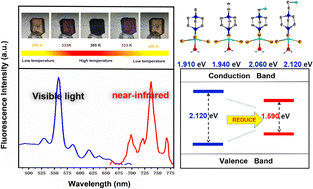Reversible thermochromism to tune the bandgap of organic–inorganic hybrid materials†
Abstract
Organic–inorganic hybrid halide materials have gained tremendous interest due to their unique optical, electrical, and magnetic properties. However, their large bandgaps limit their application. Here, we report a series of organic–inorganic hybrid halide semiconductors with rare and fully reversible thermochromatism, a narrow bandgap, and near-infrared luminescence. Through precise molecular modification, we successfully adjusted the bandgap from 1.910 to 2.120 eV and then achieved the effective temperature-derived modulation of the bandgap from 2.120 to 1.590 eV. Changing the temperature results in a reversible color change between yellow and purple-black. The intrinsic bandgap change is negligible after repeated heating/cooling cycles, indicating good thermal and environmental stability. Thermochromic behavior in hybrid structures is usually caused by lattice distortion, lattice expansion, or ion rearrangement. This work demonstrates efficient thermochromism leading to bandgap modulation, and it has great potential for intelligent window and temperature sensor applications. In addition, the thermochromism-induced bandgap narrowing provides new insights for the furthering of organic–inorganic hybrid halide materials.



 Please wait while we load your content...
Please wait while we load your content...